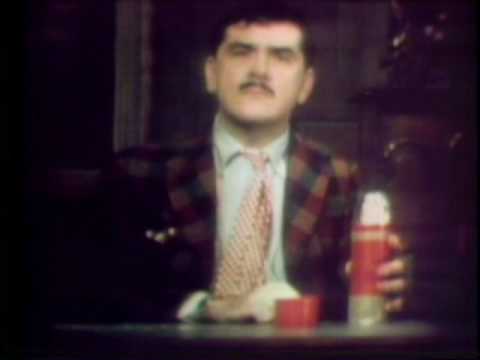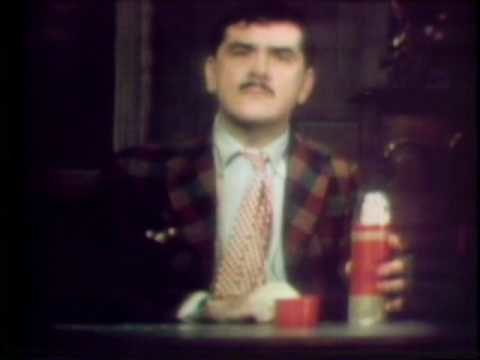

NBC’s Color Kinescopes…The Lenticular Color Film Process
NBC’s Color Kinescopes…The Lenticular Color Film Process
First, this Ernie Kovacs color clip is most likely NOT a lenticular color kinescope, but…it could be, and we will discuss that.
This is a segment from the Ernie Kovacs “Saturday Color Carnival” show dated January 19th, 1957. It was also used in the NBC 50th Anniversay Special in 1976. The “Saturday Color Carnival” shows were all done from NBC’s Colonial Theater in New York.
This Kovacs color film has been widely discussed and displayed as a lenticular kine, but it is a 16mm recording on standard color film of the time. The RCA/Eastman lenticular process used 35mm film, and no lenticular color transfers of any kind are known to exist.
The only way this could be an actual capture of the lenticular system is, if it was a recording of a live playback of the lenticular show for the west coast, or an internal playback sometime afterward.
I have read many discussions on this clip, and several describe this as an NBC color kinescope film made for limited distribution to sponsors with a modified kine, which I think may be right.
It would be a simple process to use a regular kinescope camera (with their special shutter speed needed to record live television), loaded with color film to shoot a 5″ color monitor, instead of the usual B/W monitor. Burbank probably had a modified kine machine like this they used for sponsor requests and also lenticular comparison tests.
That simple process would seem to be an elegant solution to time shifting…that is delaying an east coast live show for rebroadcast in the west, BUT! The problem was that color film could not be processed in the 3 hour window the network had to turn it around, however…black and white film could be. That is where the lenticular process comes in.
On page 40 and at the top of page 41 is a description of how the process worked from the book “Jump Cut” by video editing pioneer Art Schneider.
From the November 17, 1956 issue of “Broadcasting” here is the article on the press demonstration at NBC Burbank.
In the comment section, I have included a couple of images that show close up views of what the lenticular film surface would have looked like.
Unless the NBC engineer who recorded this pops up and let’s us in on how and when this clip was captured, we will never know if this is an off air color film capture of the live feed from New York, or a capture of the west coast lenticular playback. Either way though, this does approximate what a color film image might have looked like on the very few color screens available across the western United States in those days before color videotape, which debuted in October of 1958.
As mentioned, no lenticular color transfers of those early programs are known to exist and any example of the results of the process are presumed to be lost forever. It is possible that one or more of the original 3 strip (R,B,G) masters survived, but so far, none have surfaced.
Eastman’s “Embossed Kine Recording Film, reversal panchromatic black and white” was the special film stock used and it was discontinued in 1958. NBC’s special lenticular kine machines are long gone. -Bobby Ellerbee
https://www.youtube.com/watch?v=lEBg6ansaJA
An excerpt of Ernie Kovacs “Silent Show” from 1957. This is a very rare 50s colour kinescope film recording of a colour program using the lenticular process….
Just food for thought in regards of recovering colour from the lenticular colour kines, surely with todays digital technology there must be a way for the colour to be recovered by digital means after scanning it in high resolution. Over in the UK colour has been recovered from B&W kines of 60s/70s programs like Dr Who and Dad’s Army by means of chroma dot colour recovery https://www.youtube.com/watch?v=CjK-b4x9ZmQ .
Further to add I’ve came across a couple of other 50s colour kinescopes on YouTube most notably a 1958 partial episode The Perry Como Show which was reddish but I’ve downloaded/edited it for better looking colour pictures and reuploaded it to my oldtvhistory channel https://www.youtube.com/watch?v=DBZgR8DHwM0&t=650s , the original reddish version can be seen here https://www.youtube.com/watch?v=eMNKFDfyH_U . And there’s a clip of Sam Cooke singing “Mary Lou” on The Arthur Murray Dancy Party show from 1958 as well https://www.youtube.com/watch?v=TGoEXINk76Y . There’s a couple more earlier colour kines from 1954 known to exist in the collection of Dan Wingate which are Coke Time with Eddie Fisher and Dinah Shore Show, those have not yet made their way to YouTube or any site but were screened at the 2007 Early Television Convention thanks to the late Ed Reitan http://www.earlytelevision.org/2007_convention_reitan.html one screen cap of Dinah Shore can be seen in the presentation photos http://www.earlytelevision.org/2007_presentations.html
The Silent Show is available in its entirety on The Ernie Kovacs Collection DVD set http://www.erniekovacs.net/collection.html . I have bought it last year and watched the whole show and it was most enjoyable to watch! 🙂
From June 1957. Saturday Color Carnival opening w/ Jerry Lewis. Bad quality B&W kine of a color telecast:
Lenticular process have been around for a long time and was one of few additive color processes. The Kovacs sample does not display the lenticular pattern that such a film would have – it was really quite crude. For more information, look at he Dufray process from the durn of the century.
just nice to have this video.
Tommy Aschenbach at Colorlab has developed software to reconstruct the color of lenticular Kodacolor. This would work on lenticular color kines if he had some to scan. I recently saw some projected at 4K that looked great.
Bobby, I have handled 16mm lenticular color film, so it does exist. As far as I know, there is no way to scan lenticular in color (it looks like soft B&W on a Rank or a Spirit), but I’d like to be wrong about this.
This is a piece of lenticular film at 60X magnification with bands of lenticules clearly visible.Click to see the effect.
How lenticular film looked up close.